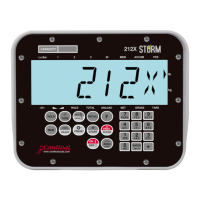212/212X Installation & Technical
8200-M639-O1 Rev D 09/14
Dual-Point without Zero (False Zero) Calibration
This calibration method requires one test weight and establishes a new
conversion factor only. It is used to establish a false (temporary zero)
zero without affecting the zero calibration value stored during the last
calibration. This is particularly useful in tank weighing applications,
where it may be impractical or impossible to completely empty the tank.
This method uses two calibration points, CAL1= and CAL2=. The value of
the test weight is entered when CAL1= is displayed and the NET/GROSS
key is pressed when CAL2= is displayed.
CAL1= – First Calibration Weight
1. The display will show CAL1=0. This is the first of two calibration
weights. This weight could be ZERO (NO LOAD) or the TEST
WEIGHTS (TEST LOAD).
2. Press the ENTER key to view the current setting.
3. If the first calibration weight is to be ZERO (NO LOAD), press the
ENTER key.
4. If the first calibration weight is to be the TEST WEIGHTS (TEST
LOAD), use the numeric keys to input the value of the test weights.
5. Place the weights on the scale platform, then press the ENTER key.
6. Starting at the left and proceeding right, a series of dashes will
appear on the display.
7. Next, starting at the left and proceeding right, the dashes will
disappear, after which the display will show: CAL2=.
CAL2= – Second Calibration Weight
1. The display will show CAL2=0. This is the second of two calibration
steps.
2. Remove the weights on the scale platform.
3. Press the NET/GROSS key.
4. Starting at the left and proceeding right, a series of dashes will
appear on the display.
5. Next, starting at the left and proceeding right, the dashes will
disappear, after which the display will show: SIO?.

